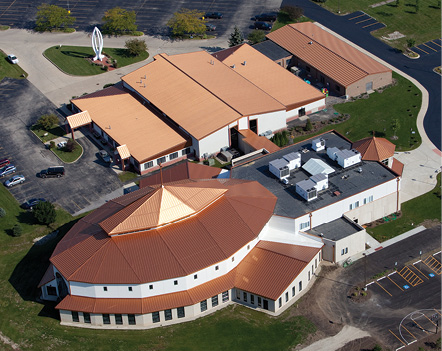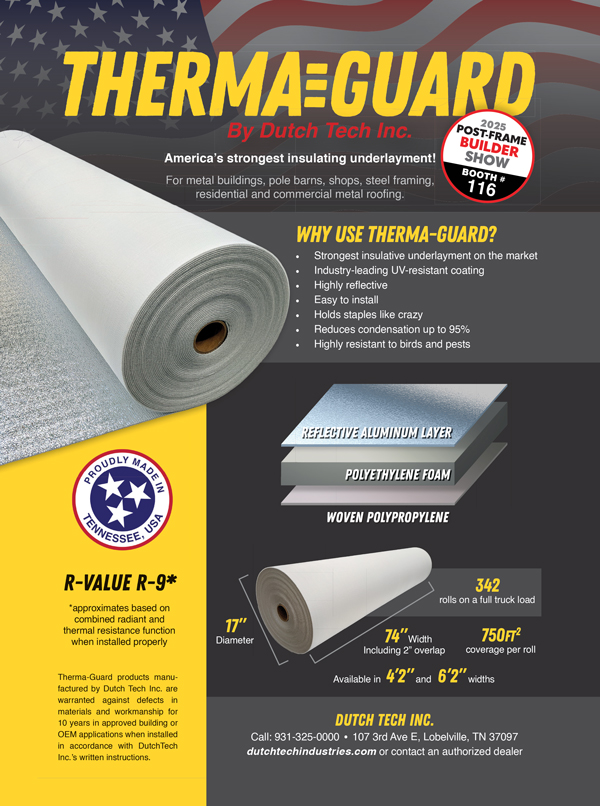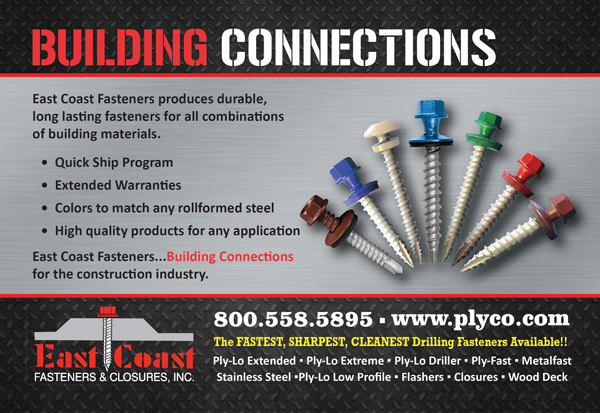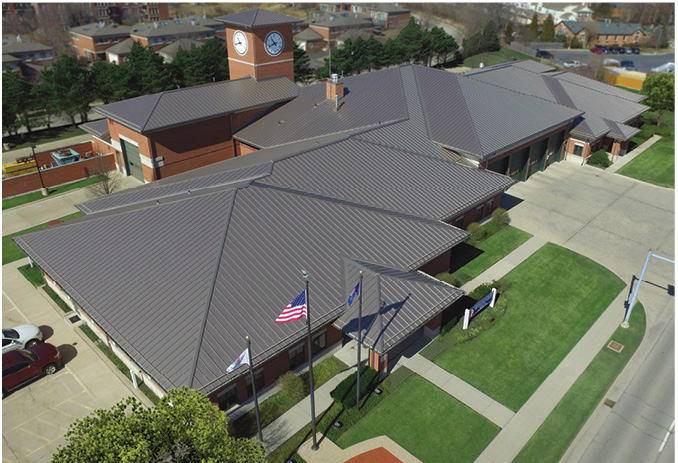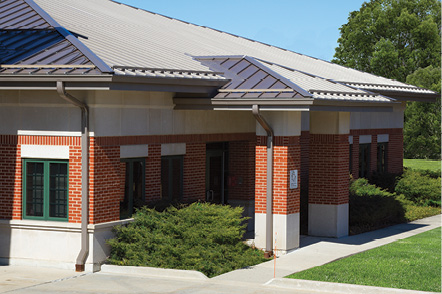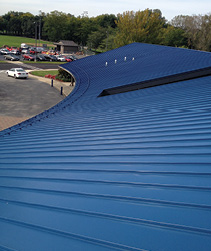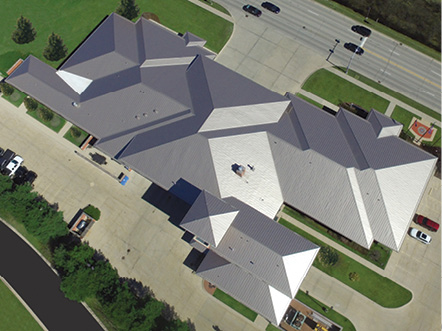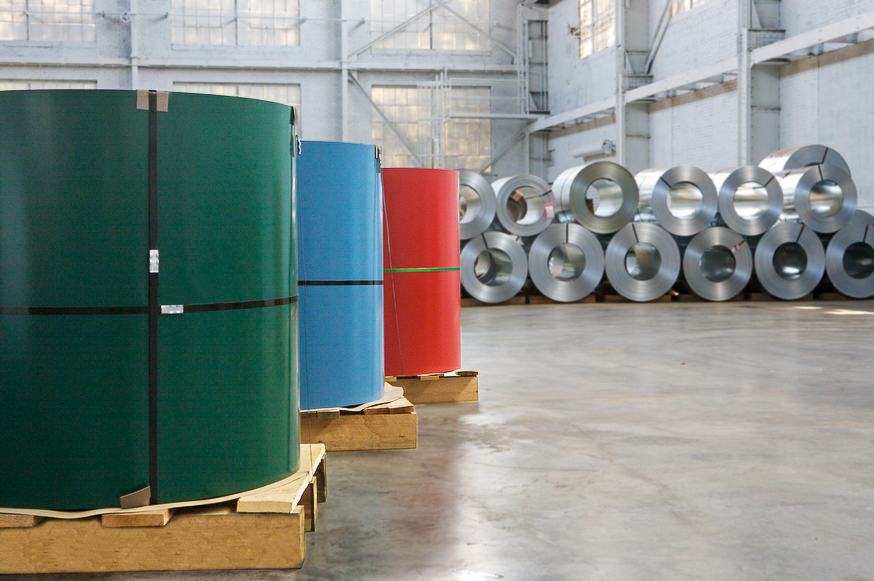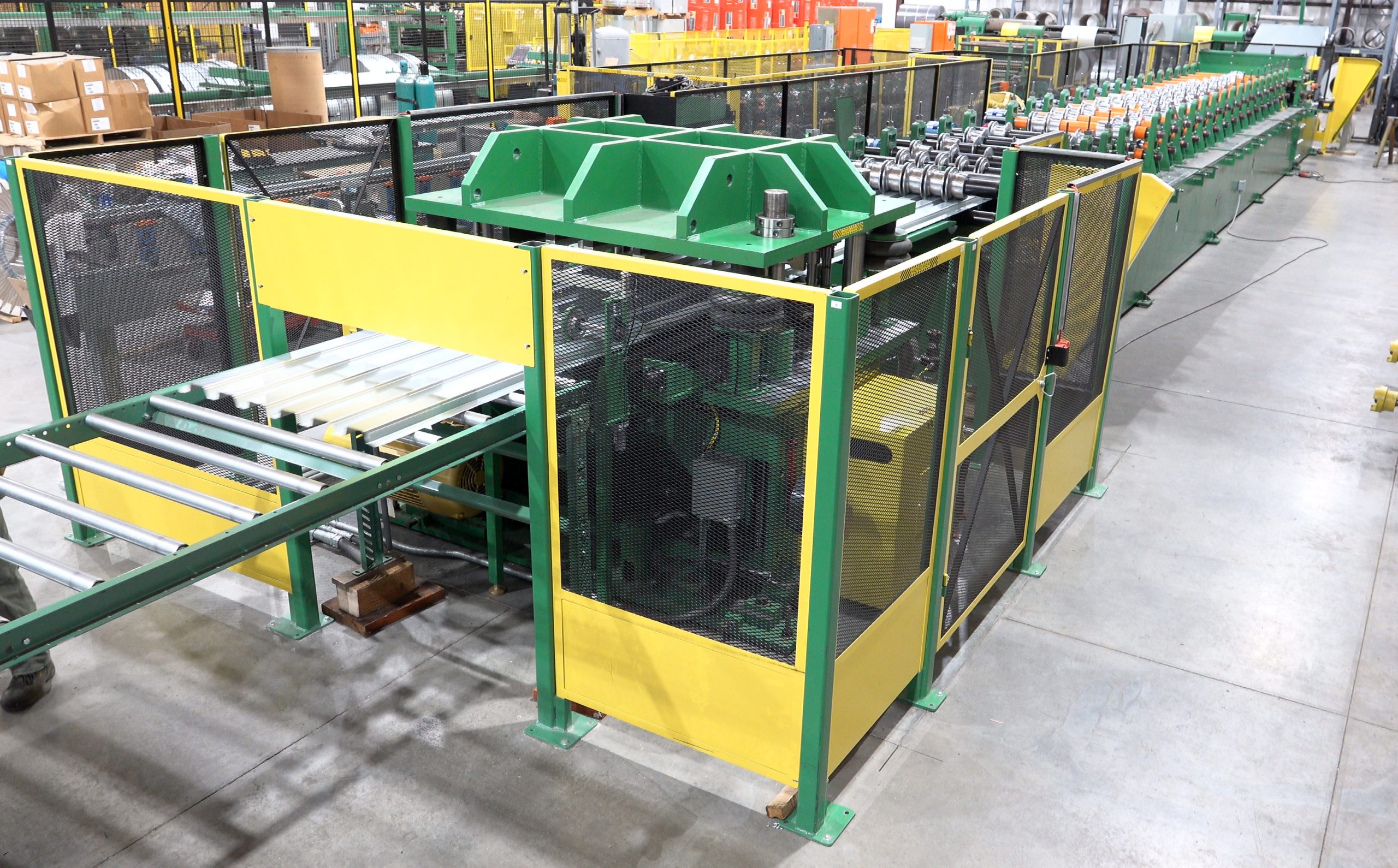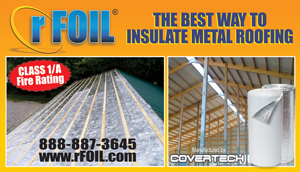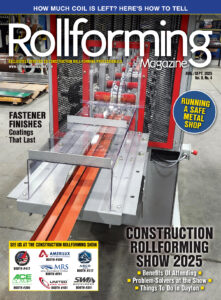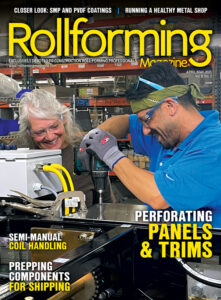The market share for metal is increasing and gaining momentum in both segments—commercial & residential.
The selling points for metal roofs are well known: longevity, aesthetics and eco-friendliness. Yet the higher cost of metal vs. other traditional roofing materials, which is usually the main objection from potential customers, is also a fact of reality. However, with increased education and the increased popularity of metal roofs over recent years, selling metal roofs has definitely gotten easier.
How to sell the benefits and overcome the objections differ on whether a contractor is selling metal roofs to the commercial or the residential market.
Commercial Challenges
The challenges of marketing metal roofing to the commercial construction sector are a daily reality for Dan Smeja, a principal at Metalmaster Roofmaster in McHenry, Illinois. A sheet metal and metal roofing contractor, the company serves a 150-mile radius around Chicago and has worked on projects ranging from schools, churches and fire departments to big-box stores and municipal buildings.
Unlike residential projects in which the contractor must pitch the benefits of metal roofing directly to a homeowner, in the commercial sector “we come on the scene to bid on projects where a metal roof has already been specified,” says Smeja. Success depends on “establishing a reputation as a premium, high-quality metal roofing contractor,” he said. “So when projects with metal roofs come along, we’ll be invited to bid.”
Metalmaster Roofmaster markets itself for commercial roofing projects in two ways. First, the company builds rapport with general contractors.
“Our reputation starts with the GCs [general contractors] and then works its way up to the architects and owners,” Smeja says. When the project team is confident that Metalmaster Roofmaster can meet the prequalification requirements and handle the job, an invitation to bid is likely.
But more commercial projects are being done using a design/build process, Smeja says. Thus, if Metalmaster Roofmaster is known as a dependable source of information on the design and pricing of metal roofing options, it can enjoy a competitive edge.
Nevertheless, says Smeja, “We can’t survive only on what we’re invited to do. The market goes in waves. Metal roofing goes through cycles of popularity, sometimes more and sometimes less. So jobs won’t always fall in our lap. We have to search every day for potential new projects.”
Metalmaster Roofmaster has a staff dedicated to this search. Leads are found in project bulletins published by BidClerk and Reed Construction Data, as well as by monitoring government agency websites for new public construction announcements.
In the end, however, Smeja says his company gets much of its work from projects whose architects already have a preference for metal roofs “or when the owner—for example, a church or an office complex—is involved in the design and has a preference for metal. As the economy improves, we’re seeing that the desire for unique buildings is coming back—and unique means metal.”
Ongoing advances in metal roofing paints and coatings help contractors such as Metalmaster Roofmaster keep up with owners’ and architects’ changing tastes.
“In the past, warmer tones were the most specified. But now we’re seeing a trend toward a more contemporary look—maybe silver, black, or panels that are prefinished to resemble specialty metals,” Smeja says.
But the main draw for metal roofs in the commercial construction sector remains their longevity.
“Metal roofs are one of the only exterior building products that can last the entire service life of a building,” Smeja says.
Though projects installed by Metalmaster Roofmaster average between $100,000 and $250,000, the higher up-front cost is offset by savings in life-cycle costs. Moreover, the cost of a metal roof is a comparatively small fraction of the total building cost.
Metalmaster Roofmaster depends on its sources for metal roofing systems, including Firestone Building Products and Berridge Manufacturing, to keep the company abreast of technical advances and aesthetic trends. These and other manufacturers, along with the Metal Construction Association (MCA), do the actual work of “selling” the benefits of metal roofing to commercial building owners and architects.
“Educating architects is a big priority for us [MCA],” says John Ryan, former director of marketing for the Chicago-based MCA. “We offer courses approved by the American Institute of Architects and we work with universities. A metal roof may be a premium cost option for a commercial building. But you’re looking at a service life of 60 or more years, vs. 20 to 30 years for traditional roofing materials.”
To sell the aesthetics of metal roofing, MCA publicizes a gallery of signature building projects.
“We show architects that they can achieve any look they want with metal,” Ryan says. The association also generates technical data to document the performance of metal roofs, including energy savings that come from a surface that reflects rather than absorbs heat like dark asphalt.
In its continuing advocacy for commercial metal roofing, MCA launched a course to certify installers.
“That will help give architects confidence to specify metal,” says Ryan. “In fact, metal roofing contractors may find in the future that to bid on a project, the owner or general contractor is going to ask if they’re certified.”
By the same token, Ryan advises contractors to source their metal roofing “from manufacturers and suppliers who are leaders in the marketplace as far as educating architects, participating in research, improving their products and actively advocating for metal.”
Residential Realities
In residential metal roofing, manufacturers and the Metal Roofing Alliance (MRA) are directly targeting homeowners with their educational efforts.
As respondents to a Metal Roofing Magazine survey published every February on the state of the industry, education remains the key. As one manufacturer put it recently, “People aren’t flipping houses anymore; they are choosing to stay where they are. They want value in their homes and you get that with a metal roof.”
According to MRA executive director Renee Ramey, this is true. “The latest market data shows homeowners are choosing to stay in their homes longer. They view their home as an investment and, as such, understand the true value a metal roof can bring to their home,” says Ramey.
Yet the latest market research conducted by MRA also has discovered some misperceptions among homeowners about the benefits of metal roofing.
“We are here to share the facts about metal roofing in detail. The MRA is working to educate homeowners about the wide variety of metal roofing products available … from those that mimic slate, shake and tile, to vertical seam and stone-coated products. In short, it’s important for homeowners to realize that metal roofing can aesthetically look like virtually any other roofing material available,” shared Ramey.
Beyond aesthetics, metal roofing offers a wide variety of benefits—including durability, sustainability, ease of maintenance, longevity and more—that appeals to homeowners in many different regions.
“Homeowners need to understand that metal roofs do not increase the likelihood of lightning strikes, are not noisier than other roofs in rain or hailstorms, and do not rust like the roof on your old red barn,” says Ramey. “In fact, more than any other type of roof, metal can withstand hail, high winds and snow without denting or compromising performance.”
An Investment
That Pays Off
According to Ramey, metal roofing products are not a commodity but rather an investment that also pays off for the trades. “Profit margins are better for metal than for most other roofing products, allowing contractors to achieve higher revenue with fewer projects. In fact, for about two-thirds of contractors who install metal roofs, that’s all they do,” she says.
To help support the trade, MRA offers a suite of marketing and sales tools. For contractors, the biggest benefit of MRA membership are homeowner-generated leads available via the MRA website. In addition, the MRA offers everything from customizable literature and signage, to training and access to technical support. “Of course, this support is in addition to the ongoing consumer-focused promotional efforts we do, including TV, radio, print, digital, social and virtually every other platform designed to reach homeowners both nationally and regionally,” adds Ramey.
Homeowners who visit the MRA website can upload photos of their homes and actually see what different styles and colors of metal roofing would look like on their home. This tool also is a tremendous asset for contractors, since potential customers don’t have to guess what their home would look like with a new metal roof.
In contrast to selling a commercial metal roof, which means getting on a bid list, selling a residential metal roof means getting into a homeowner’s living room. The latter requires a mix of advertising, marketing and public relations. Advertising influences the buying behavior of targeted consumers, marketing promotes a product or service to those consumers and public relations secures goodwill from consumers, as well as local officials and others part of the decision-making process.
Integrating these three activities—advertising, marketing, public relations—into a single plan involves four steps: research, planning, communication and evaluation. The first step, research, identifies the target audience, its attitudes toward metal roofs, messages that may change those attitudes and available media for conveying those messages.
The goal of the second step, planning, is deciding on a mix of media tactics that give the most bang for the budget (which is usually set as a percentage of annual sales). Communication, the third step, is executing a “creative and content strategy” geared to consumer education. The final step, evaluation, helps launch the research and refinement phase for the next campaign.
Following The Steps
To Close The Sale
These steps help mirror consumer education campaigns of the manufacturers and the MRA on a local level. National advertising and marketing create a “brand presence” for residential metal roofs, while contractors’ local efforts create opportunities to make a personal pitch with interested prospects and close the sale.
The good news for metal roofing is that market share within the residential arena is increasing. A study by F.W. Dodge reports that the market share for residential metal roofing hit a record 12 percent in 2017. The market continues to increase as the MRA’s educational efforts, and those within our industry, work to drive consumer education and awareness.
Respondents to the Metal Roofing Magazine state-of-the-industry survey agreed that such multilevel education remains the key. “As people know more about it, they see the benefits of the quality products, the greener aspects and the more sophisticated options,” said one manufacturer. Added another: “The industry . . . [is] making great strides to educate consumers about the benefits of metal roofing and I think that effort trickles down to everyone.”
The good news, though, is that the market share for metal is increasing in both commercial and residential segments. For example, the market share for residential metal roofing more than tripled between 2000 and 2008, climbing from about 3.5 percent to 11 percent and year after year those figures keep rising. RF
- Ongoing advances in metal roofing paints and coatings help contractors such as Metalmaster Roofmaster keep up with owners’ and architects’ changing tastes. The main draw for metal roofs in the commercial construction sector remains their longevity.
- Beyond aesthetics, metal roofing offers a wide variety of benefits including durability, sustainability, ease of maintenance, longevity and more that appeals to homeowners in many different regions.
- Ongoing advances in metal roofing paints and coatings help contractors keep up with architects’ changing tastes.
- In contrast to selling a commercial metal roof, which means getting on a bid list, selling a residential metal roof means getting into a homeowner’s living room.


